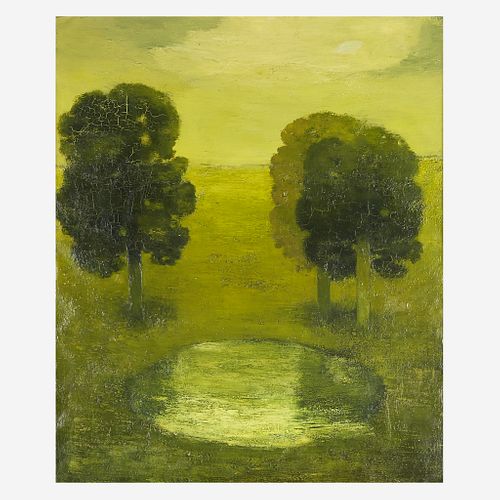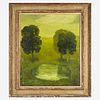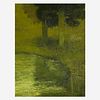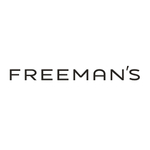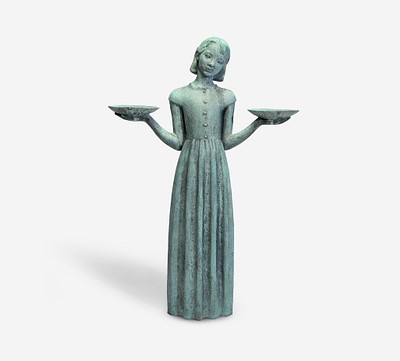Albert York (American, 1928–2009) Reflections in the Pond
About Seller
2400 Market St
Philadelphia, PA 19147
United States
Established in 1805, Freeman’s Auction House holds tradition close, with a progressive mind-set towards marketing and promotion, along with access to a team of top experts in the auction business. And now with offices in New England, the Southeast, and on the West Coast, it has never been easier to ...Read more
Two ways to bid:
- Leave a max absentee bid and the platform will bid on your behalf up to your maximum bid during the live auction.
- Bid live during the auction and your bids will be submitted real-time to the auctioneer.
Bid Increments
| Price | Bid Increment |
|---|---|
| $0 | $25 |
| $500 | $50 |
| $1,000 | $100 |
| $2,000 | $200 |
| $3,000 | $250 |
| $5,000 | $500 |
| $10,000 | $1,000 |
| $20,000 | $2,000 |
| $30,000 | $2,500 |
| $50,000 | $5,000 |
| $100,000 | $10,000 |
About Auction
Jun 6, 2021
Freeman’s is pleased to present Sylvia Shaw Judson’s Bird Girl, the highlight of the June 6 auction. In addition to the sculpture, this auction will also feature several notable works by significant American artists, including Daniel Garber, Norman Rockwell, Edward Redfield, and William Harnett. Freeman's info@freemansauction.com
- Lot Description
Albert York (American, 19282009) Reflections in the Pond
Oil on canvas
24 x 20 in. (61 x 50.8cm)
Executed circa 1960.
Provenance
The Artist.
Davis Galleries (now Davis & Langdale Company Inc.), New York, New York.
Acquired directly from the above.
Private Collection, Reading, Pennsylvania.
Private Estate, Reading, Pennsylvania.
Footnote:Exhibited
Paintings by Albert York, Davis Galleries (now Davis & Langdale Company Inc.), New York, New York, March 25-April 13, 1963, no. 14.
Albert York, Davis & Long Company (now Davis & Langdale Company Inc.), New York, New York, February 22-March 22, 1975, no. 8.Note
The present work will be included in the forthcoming Catalogue Raisonné of the artist's work being compiled by Cecily Langdale, of Davis & Langdale Company, Inc., New York. We wish to thank Cecily Langdale for her kind assistance in cataloguing this lot.
Reflections in the Pond is an important, early painting by Albert York, included in the artist's first solo-show at Davis Galleries in 1963. The show received good reviews, and all the included paintings sold out. This misty view of trees flanking a pond in which one of them is reflected was one of York's favorite motifs. About the work, scholar Martin Herbert says: "God knows what time of day or night it is – the scene looks dipped in precious metals." The painting, scarce in detail but strong in composition, is almost all about the ambient, eerie, atmosphere. In his 1975 essay about the artist, Fairfield Porter, who was one of York's early admirers, saw in the trees a reinterpretation of the myth of Baucis and Philemon, whom Zeus changed into trees at their death to grant them their wish to never be separated.
ABOUT ALBERT YORK
“Albert York may be the most highly admired unknown artist in America.” Calvin Tomkins used this bold statement to introduce the artist to the public for the first time in a New Yorker profile on June 19, 1995. Twenty-six years later (and more than ten years after York's death), it still resonates, as the artist remains anonymous to most art historians, dealers and collectors, and his work is still relatively rare at auction. In fact, Albert York stands out in the panorama of American artists from the second half of the 20th century. A contemporary of Fairfield Porter, Andrew Wyeth and Milton Avery, his paintings explore a different vein of contemporary realism, seemingly void of any narrative, and voluntarily oblivious to the trends of contemporary abstract art, which York considered a totally "different world." York himself was somewhat of a mysterious figure. The only known image of the artist published in the New York Times portrays a rather handsome and imposing character, yet he also timidly looks away from the photographer, with a constricted smile on his face. York was known as a reclusive man, who purposely avoided the spotlights of the art world, declined interviews and did not seek fame through the traditional exhibition route. For a certain time, it was even speculated that York never in fact existed and was a persona invented by his dealer; even his own wife, Virginia M. Caldwell, is said to have discovered her husband was a painter a full six months after they were married.
York was born in Detroit in 1928, a year before the Great Depression. He spent a lonely childhood, deprived of the presence of his mother, and later his father as he progressed through boarding school alone in Michigan. Later in life, he went to live with his aunt while enrolled at the Ontario College of Art. However, York only spent one year there, before attending the Society of Arts and Crafts in Detroit. His experience, based mostly on drawing, was again cut short as he enrolled in the Army and was deployed to Korea. Upon his return to the United States in 1952, York settled in New York, where he stayed for most of his life until his passing in 2009. At first, he contemplated the idea of joining the Art Students League but was ultimately discouraged by the school's high fees. Eventually, he signed up for Raphael Soyer's evening painting classes - which he quickly abandoned to start working as a gilder in Robert Kulicke’s picture-frame workshop. It was there that York’s career took a drastic turn. A full ten years into their working relationship, Kulicke discovered York’s true talent and decided to introduce him to Roy Davis, a friend and fellow artist who ran an art gallery on the Upper East Side along with his wife, Cecily Langdale. Davis immediately believed in York and gave him his first solo-show in 1963, the year after Pop art broke out. Several more followed and soon, a small and loyal group of collectors became admirers of the artist's work. Among them were Jacqueline Kennedy Onassis, who owned five Yorks, Paul and Bunny Mellon (they owned three), Werner and Sarah-Ann Kramarsky (nine), Edward Gorey (five) and Lauren Bacall (three). Today, York's compositions can be seen in the collections of world-famous museums such as the Metropolitan Museum in New York, MoMA, the Cleveland Museum of Art as well as the Art Institute of Chicago.
York's works are characterized by a certain darkness (usually rendered via a myriad of muted, green hues), as well as by an economy of brushstrokes, which the artist applied on usually small-sized works, most often panel sheets he would find and pick up on his numerous construction jobs. There is a sense of quietness, privacy and almost isolation to his work, some being arguably uneasy and bizarre such as Trees and Pond (Lot 43) a work whose overall quietude and silent angst channels the mood of an Edward Munch. In fact, many of his works seem to rely on the tension between real and imaginary: are the flowers and trees that we see in the paintings real or dreamed? Although his subject matter is realistic and inspired by what he saw, York did not directly work from nature, en plein air. Instead, he always reinvented his subject, painting from memory several days later in his studio, to capture the "essence" of the subject. York wanted to share his positive and child-like view of the world, explaining: "I think we live in a paradise. This is just a Garden of Eden, really it is (...) It's just so beautiful, with the trees and everywhere here, and you feel you want to paint it."
As apparent in the six works on offer, especially Still Life: Green Apples (Lot 47) and Ostrich Feathers (Lot 45), York's paintings owe a great deal to European artists such as Édouard Manet, Paul Cézanne and Giorgio Morandi. His inspiration also remained rooted in American Art, with strong influences from Thomas Eakins, the Ashcan School as well as Albert Pinkham Ryder, whom York discovered during a visit to the Met: “the whole universe was there in those small pictures” he said. From Ryder, York borrowed a simplicity of forms and themes. Concise and modest, his panels stand out to the viewer with a disarming rawness and purity that convey sentimentality, and a lyrical quality, making the viewer feel the subject, be aware of its physicality, instead of passively viewing it. This trait has led him to be called the "Painter of the Ordinary," the one capable of revealing the inherent beauty of quotidian items, the one painting without fuss, but pure honesty, making Susan Rothenberg believe: “each time he paints, he paints for the first time." Such is revealed by the modesty of the present six works' format, title, medium and quick execution.
The six works on offer all are from the same private collection in Reading, Pennsylvania, and were directly acquired through York's lifetime dealer, Roy Davis. Their sale is an important milestone as never before have so many works by the artist been offered at the same time (York is said to have only painted about two-hundred works throughout a thirty-year long career). Reflections in the Pond (Lot 43), Jar of Wildflowers (Lot 44), Ostrich Feathers (Lot 45), Cow (Lot 46), Still Life: Green Apples (Lot 47) and Rose Against a Sand Background (Lot 48) reveal the trained eye and eclectic taste of their collector, who appreciated York's plain cow in a field as much as the lush bouquet of wildflowers in a jar. They also speak for York's incredible scale and versatility (although he was often critical of his work) as they feature all the simple, familiar subjects York was naturally drawn to, and which he explored through in a variety of media and formats, with a real sense of innovation and eye for beauty.
Condition report:The unlined canvas in overall good condition, with selective paint crackling/crazing in the trees at upper left and center right. Some light ripples in the canvas along the left outer edge as well. Examination under UV light reveals a small repair in the sky at upper right, as well as light retouching at bottom left and bottom center left along the top outer edge (most likely inpainted abrasions caused by frame rubbing). With a rich texture in the foreground. See Specialist's pictures for more details
Frame: 30 3/4 x 27 x 1 1/2 in. - Shipping Info
-
No lot may be removed from Freeman’s premises until the buyer has paid in full the purchase price therefor including Buyer’s Premium or has satisfied such terms that Freeman’s, in its sole discretion, shall require. Subject to the foregoing, all Property shall be paid for and removed by the buyer at his/ her expense within ten (10) days of sale and, if not so removed, may be sold by Freeman’s, or sent by Freeman’s to a third-party storage facility, at the sole risk and charge of the buyer(s), and Freeman’s may prohibit the buyer from participating, directly or indirectly, as a bidder or buyer in any future sale or sales. In addition to other remedies available to Freeman’s by law, Freeman’s reserves the right to impose a late charge of 1.5% per month of the total purchase price on any balance remaining ten (10) days after the day of sale. If Property is not removed by the buyer within ten (10) days, a handling charge of 2% of the total purchase price per month from the tenth day after the sale until removal by the buyer shall be payable to Freeman’s by the buyer. Freeman’s will not be responsible for any loss, damage, theft, or otherwise responsible for any goods left in Freeman’s possession after ten (10) days. If the foregoing conditions or any applicable provisions of law are not complied with, in addition to other remedies available to Freeman’s and the Consignor (including without limitation the right to hold the buyer(s) liable for the bid price) Freeman’s, at its option, may either cancel the sale, retaining as liquidated damages all payments made by the buyer(s), or resell the property. In such event, the buyer(s) shall remain liable for any deficiency in the original purchase price and will also be responsible for all costs, including warehousing, the expense of the ultimate sale, and Freeman’s commission at its regular rates together with all related and incidental charges, including legal fees. Payment is a precondition to removal. Payment shall be by cash, certified check or similar bank draft, or any other method approved by Freeman’s. Checks will not be deemed to constitute payment until cleared. Any exceptions must be made upon Freeman’s written approval of credit prior to sale. In addition, a defaulting buyer will be deemed to have granted and assigned to Freeman’s, a continuing security interest of first priority in any property or money of, or owing to such buyer in Freeman’ possession, and Freeman’s may retain and apply such property or money as collateral security for the obligations due to Freeman’s. Freeman’s shall have all of the rights accorded a secured party under the Pennsylvania Uniform Commercial Code.
-
- Buyer's Premium



 EUR
EUR CAD
CAD AUD
AUD GBP
GBP MXN
MXN HKD
HKD CNY
CNY MYR
MYR SEK
SEK SGD
SGD CHF
CHF THB
THB